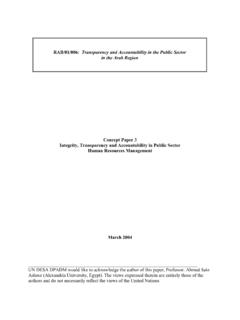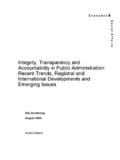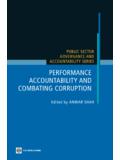Transcription of Governance, Corruption and Public Financial Management
1 CONTENTSF orewordvYoshihiro IwasakiChapter 1 governance , Corruption , and Public Finance:An Overview1 Vito TanziPart I Public Financial MANAGEMENTC hapter 2 Government Policies and theBudget Process21 Francesco ForteChapter 3 Public Financial Management :Getting the Basics Right47 Arigapudi PremchandChapter 4 Information and Communication Technologyfor Public Finance89 Clay Wescott and Salvatore Schiavo-CampoChapter 5 Reform Priorities for Public FinancialManagement in Developing Countries107 Salvatore Schiavo-Campo andDaniel TommasiChapter 6 Beyond the Basics: The Philippine Case135 Benjamin DioknoIVGOVERNANCE, Corruption , AND Public Financial MANAGEMENTPart II Public Financial ACCOUNTABILITYC hapter 7 Public Financial Accountability145 Arigapudi PremchandChapter 8 Transparency and Accountability forPublic Financial Integrity193 Nihal JayawickramaChapter 9 Some Observations on Public FinancialAccountability and integrity inPacific Island Countries207 Savenaca SiwatibauChapter 10 Public Financial Accountability for Integrityand Results.
2 The Case of the PhilippineBureau of the Treasury219 Leonor BrionesAnnexesIAn Anti- Corruption Policy for Asiaand the Pacific233 Asian Development BankIIThe IMF Code of Fiscal Transparency243 Note on Contributors250 FOREWORDR eflecting the evolving needs of Asia and the Pacific, theAsian Development Bank has been transforming itself fromprimarily a project lender to a broad-based development insti-tution. This transformation is consistent with the internationalconsensus that the development impact of external assistanceis crucially linked to the soundness of the recipient country seconomic and social successful implementation of such policies is in turnlinked to the quality of governance and the caliber of a givencountry s Public sector. It is in recognition of this linkage thatthe ADB approved in 1995 a policy paper on governance forSound Development Management , and in July 1998 an Anti- Corruption Policy.
3 These policies on governance and anticor-ruption can only be translated into practice by significant andsustained improvements in the efficiency, integrity , and effec-tiveness of Public -sector Management , and also in accountabil-ity and transparency of corporate and Financial governance inthe private sector. This is indeed one of the many lessons of theAsian Financial crisis. The Bank is determined to heed theselessons and help its member countries turn crisis into oppor-tunity for renewed economic and social progress on a new andstronger basis. Among the many areas of Public -sector improve-ment, strengthening the Management of and accountability forpublic expenditure is challenges faced by developing countries are tostrengthen fiscal discipline, bring resource allocation in line withpolicy priorities, create an enabling environment for publicfinancial managers, and protect due process.
4 The Bank can assistby putting at their disposal the basic conceptual framework,the principles of good budgeting, a synthesis of internationalconsensus on desirable reforms, and the lessons of internationalexperience, both the successes and the failures. This book isone step in this direction. It is our hope that it will prove ofVIGOVERNANCE, Corruption , AND Public Financial Management practical value and of interest. It is based on a selection of paperspresented at two major events organized by the ADB: a Semi-nar on Public Financial Management and Accountability at the1999 Annual Meeting and the ADB-organized module on thesame subject at the World Conference on governance in Ma-nila in June 1999. Our sincere thanks go to all the eminentcontributors, as well as Marilyn Pizarro for research assistance,Me-an Asico for copy-editing, Merly Mallion for organizationalassistance, and Ruby de Vera for production IwasakiChief, Strategy and Policy OfficeAsian Development BankChapter 1 governance , Corruption , andPublic Finance: An OverviewVito TanziIntroductionGrowing attention has been directed in recent years to the roleof government.
5 governance in general and Corruption inparticular have been much discussed because of the way theyaffect, and are affected by, the role of government. Dictionariesgenerally define governance as government. Thus, goodgovernance is good government. In recent writing, however, governance has taken on a more substantive, though still notprecisely defined, governance is an essential part of a frameworkfor economic and Financial Management which also includes:macroeconomic stability; commitment to social and economicequity; and the promotion of efficient institutions throughstructural reforms such as trade liberalization and governance may result from factors such asincompetence, ignorance, lack of efficient institutions, thepursuit of economically inefficient ideologies, or misguidedeconomic models. It is often linked to Corruption and rentseeking.
6 A good part of this paper will thus deal with , it should be understood that Corruption is notidentical with poor governance , which extends well beyondcorruption, although poor governance often leads tocorruption and Corruption is an important element of , Corruption , AND Public Financial MANAGEMENTB efore dealing with governance and Corruption issuesvis- -vis Public revenue and Public expenditure, I would liketo note two simple relationships emerging from internationalexperience: (i) Corruption is generally less frequent in richercountries; and (ii) there is a negative correlation between therate of growth and Corruption . Thus, more corrupt countriestend to be poorer, and to grow slower (if at all).CorruptionViews about Corruption have undergone a great change in recentyears. Not too many years ago, the economic successes of thecountries of South East Asia were attributed by some observersto a presumably positive impact of Corruption on facilitatingdecision making.
7 However, after the crisis of 1997 1998, theseviews changed and many observers, both inside and outsidethe crisis countries, blamed Corruption for the crisis. Forexample, it was pointed out that some individual investors hadbeen able to borrow very large sums from banks at low rates,sums which had been invested in highly questionable the crisis there has been a strong interest in increasingthe transparency of institutions and in promoting more arm slength relationships in economic deals. Whether this interestwill generate concrete changes remains to be has also attracted a lot of attention in Russia,Pakistan, Kenya and many other countries. Many observershave connected the poor functioning of these economies tovarious governance problems. In fact, there is now a growingawareness among economic observers and economists thatthese governance problems have a negative impact on eco-nomic performance.
8 For this reason, the new architecture forthe world Financial system is paying a lot of attention totransparency and governance issues. Standard and codes ofconduct are being developed and countries are being urgedto adhere to , Corruption , and Public Finance: An Overview3 Several international organizations including theAsian Development Bank, the International Monetary Fund,the Inter-American Development Bank, the OECD, and theWorld Bank have intensified their work in this area and havebeen promoting a campaign against Corruption and for moretransparent and well-governed economies. The work of theseinstitutions has been complementary and with a commonobjective, namely, to promote good governance and by sodoing to improve the quality of policy making. It is hopedthat this improvement will reduce the frequency and severityof Financial crises and will promote economic recent years, some economists presented whatcould be called a romantic view of Corruption .
9 Such a view madecorruption seem almost a virtuous activity. For example, it wasargued that Corruption oiled the economic mechanism or greased the economic wheel and made economies moreefficient by removing rigidities which put obstacles toinvestment and economic activity in general. Some argued thatcorruption allocated investment to the most efficient uses because the most efficient investors would be able to paythe highest bribes. Some argued that even the efficiency inthe use of time could be improved by Corruption becausethose whose time was most valuable could save on its useby paying the highest bribes to move in front of bureaucraticlines. Finally, it was even argued that Corruption made itpossible for the government to keep wages low because thebribes that the Public sector employees received made themaccept lower wages.
10 Low wages allowed taxes to remain lowand low taxes stimulate growth. Various theoretical articlessupported these somewhat unorthodox and at times evenbizarre romantic view of Corruption has been replaced, inmore recent years, by a more realistic and much less favorableview. In fact, the more recent view is that, rather than being theoil that lubricates the economic mechanism, Corruption is therust that slows it down. It has been argued that rigidities created4 governance , Corruption , AND Public Financial MANAGEMENTby regulations are not God given but are, rather, man createdand thus endogenous to the system. Once bureaucrats realizethat they can take advantage of regulations, they will producemore of these. There will thus be more regulations and thesewill probably become less transparent. The highest bribes willbe paid not necessarily by those most efficient at producingbut by those most efficient at rent seeking.



















